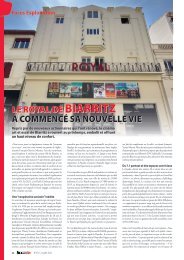You also want an ePaper? Increase the reach of your titles
YUMPU automatically turns print PDFs into web optimized ePapers that Google loves.
SPECIAL FEATURE: Books On Cinema——<br />
GREENE ROOM<br />
An Excerpt From "Hollywood Migraine," A Collection<br />
of Articles and Interviews by Entertainment Journalist Ray Greene<br />
HOLLYWOOD MIGRAINE:<br />
THE INSIDE STORY<br />
OF A DECADE IN FILM<br />
by Ray Greene<br />
Merlin Publishing<br />
336 pgs./$ 15.95<br />
"Megaciratits Incorporated "<br />
few months ago<br />
A<br />
1 was fortunate<br />
enough to spend an afternoon in<br />
the company of a legendary and<br />
still active film producer whose career<br />
extends all the way back into the early<br />
1950s. His conversation was wide ranging,<br />
opinionated, at times cantankerous,<br />
and instructive in almost every regard.<br />
He had war stories to tell: delightful<br />
tales of colorful personalities in exhibition<br />
and independent distribution, of<br />
booking deals cut at the last possible<br />
minute in bare-bulb back offices, of<br />
improvised strategies that beat his competitors<br />
to the punch. In a few quick sentences<br />
he conjured up a time when the<br />
men who made the movies and the people<br />
who screened them sat down face to face<br />
to hash out the details of getting product<br />
to the public, a time long gone in an<br />
industry where both distribution and<br />
exhibition are mostly run by vast bureaucracies<br />
as opposed to the gut instincts of<br />
a hustling handful, flying through each<br />
deal by the seat of their pants.<br />
Our conversation wandered into the<br />
contemporary exhibition scene. He was<br />
mindful of the technological transformations<br />
of the past decade or so, of the<br />
improvements in presentation that have<br />
done so much to bring audiences back<br />
into moviehouses. But he sounded an<br />
interesting cautionary note I hadn't<br />
heard elsewhere when he said that, the<br />
way things were going, the film industry<br />
might easily blunder its way into a situation<br />
not unlike the one it got caught up<br />
in during the late '40s and early '50. To<br />
describe what he meant, he actually used<br />
the word "antitrust."<br />
What this very experienced industrywatcher<br />
was getting at is at the core of<br />
several of the more overwhelming trends<br />
in the exhibition field during recent<br />
times. In the late '40s, when studioowned<br />
circuits booked studio-created<br />
product for studio-derived profits, the<br />
U.S. government decided that much of<br />
exhibition was in fact operated according<br />
to monopolistic principles. The<br />
result became known as the "consent<br />
decree": the court-ordered divestiture by<br />
the studio production centers of the studio-owned<br />
circuits, an event which split<br />
the exhibition field wide open for a time.<br />
By 1953. when MGM— the last<br />
Hollywood holdout—severed its lies to<br />
the Loews Inc. chain, studio ownership<br />
of moviehouses was a thing of the past.<br />
Or so it seemed.<br />
In fact, though it took a few decades.<br />
many of the studios have again become<br />
important partners in the exhibition<br />
field. The word "partners" is significant<br />
here: In most cases, major circuits with<br />
direct studio ties are co-owned rather<br />
than owned outright by their studio foster<br />
parents, an important distinction in<br />
drawing analogies with the past. The<br />
word "studio" is also in need of redefintion,<br />
since the vast, multi-tiered, full-service<br />
entertainment corporations of today<br />
(in which movie production and distribution<br />
rarely account for the primary revenue<br />
stream) are a far cry from the one<br />
company, one product" approach of<br />
Hollywood's formative moguls.<br />
Put succinctly, there is not today and<br />
probably never can be anything resembling<br />
the closed dominance over<br />
American production, distribution and<br />
exhibition that a handful of companies<br />
exercised half a century ago. The situation<br />
is far more amorphous than it once was.<br />
Vast independent circuits such as<br />
Carmike, Regal and United Artists sit<br />
atop the list of exhibition's largest companies<br />
and a close examination of the manner<br />
in which those circuits with direct studio<br />
ties formed studio alliances indicates<br />
that, in most cases, they are a haphazard<br />
by-product of a more general and industry-wide<br />
trend toward consolidation.<br />
That consolidation itself, however, is<br />
both the biggest exhibition story of our<br />
time and an at least potentially worrying<br />
development for the long term. The<br />
building spree of the last five years has<br />
seen the U.S. market grow in terms of<br />
sheer screen count at an unprecedented<br />
rate. North America, already the most<br />
well-screened and competitive movie<br />
market in the world at the start of the<br />
1990s, has now become an almost "kill<br />
or be killed" competitive situation. This<br />
is particularly true in those coveted population<br />
centers capable of sustaining the<br />
modern equivalent of the movie palace:<br />
the state-of-the-art megaplex of 20<br />
screens or more, a type of build for<br />
which there was no prototype a decade<br />
ago, but which has emerged in the 1990s<br />
as the industry standard.<br />
Though offering multiple opportunities<br />
for economies of scale, megaple.xes<br />
are costly to build and costly to operate,<br />
and therefore need to maintain a high<br />
rate of attendance to stay profitable.<br />
That the time was right for such a development<br />
within the exhibition industry is<br />
demonstrated by the overall success of<br />
the megaplex model at luring audiences<br />
back into the American moviehouse; the<br />
continuing and uninterrupted climb in<br />
the U.S. attendance figures charted by<br />
the National Association of Theatre<br />
Owners (NATO) and the MPAA in<br />
recent years can be attributed in no<br />
small measure to the lure of megaplexstyle<br />
complexes in urban and heavily<br />
populated suburban markets.<br />
Still, there is grumbling afoot. Last<br />
year NATO president Bill Karto/ian used<br />
the occasion of his address to exhibitors<br />
at the industry's ShoWest convention to<br />
coin a phrase that snapped into focus a<br />
fear already on a lot of people's minds.<br />
and he did so in terms worthy of an 1 1th<br />
commandment: "Thou shall not Ontario<br />
one another." The reference, of course,<br />
was to the infamous competitive situation<br />
that two major, well-run. seemingly ratio-<br />
4X Boxoii [( i

















